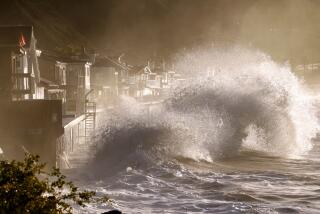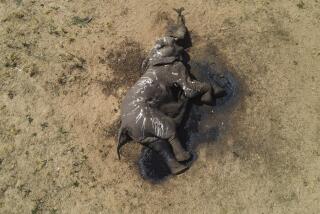El Nino Update
- Share via
As El Nino storms continue to strike several areas of the world, the extent of the damage and death toll in the two hardest hit countries is just now becoming apparent.
Mudslides and flooding triggered by El Nino in Peru and Ecuador since mid-December have killed at least 300 people and left more than a quarter of a million others homeless. Those figures are double the number of deaths and destruction that occurred during the previous record El Nino in 1982-83.
In Venezuela, El Nino produced a record heat wave in the normally temperate capital of Caracas, where the temperature soared to 91 degrees Fahrenheit. Neighboring Colombia is in the midst of a drought due to the ocean-warming phenomenon. The dry spell may cause a drop in production for the country’s key coffee export crop.
Awakening Giant
A sudden swarm of tremors deep within Japan Mount Fuji is sparking concerns among the country’s seismologists that the mountain may awaken following a period of dormancy that has spanned 12 generations. The mountain last erupted in 1707, but has been a symbol of tranquility for the Japanese during the past 200 years. Should Fuji erupt, it could shower nearby Tokyo’s 12 million residents with ash and other debris.
El Nino Upside
It’s hard to find any good news resulting from El Nino, but some of the rains that have fallen in Africa due to the phenomenon are helping to replenish wildlife in the skies and lakes of Kenya.
The number of flamingoes migrating to waters of Lake Nakuru in the Rift Valley dwindled during recent years. But this season’s heavy rains have filled the alkali lake to the brim, and 1.5 million flamingoes have returned to feed in its warm, brackish waters.
Mammals have also benefited from the abundance of food created by the rains. Sleek, well-fed lions can be seen resting in the low-slung branches of acacia trees near the banks of Nakuru, watching their playful cubs rolong grass below.
Earthquakes
Powerful aftershocks continued to rumble through Afghanistan where a magnitude 6.1earthquake wrecked the region Feb. 4
A moderate earthquake cracked roads and damaged a pier on the Philippine island of Leyte, but there were no immediate reports of injuries.
Earthquakes were also felt in Guam, eastern Indonesia, Taiwan, Japan’s southern islands and northern Hokkaido Island, western Iran, southern Greece, southern Mexico, Missouri andcentral Alaska.
Wildfires Spread
Bushfires spread further across the Indonesian side of Borneo as scorching drought plagued the region for a seventh month. More than 3,600 acres of forest were destroyed during theweek, endangering countless birds, iguanas, monkeys and other animals. The fires areflushing orangutans from their habitats and into populated areas.
Additional Sources: U.S. Climate Analysis Center, U.S. Earthquake Information Center andthe World Meteorological Organization
More to Read
Sign up for Essential California
The most important California stories and recommendations in your inbox every morning.
You may occasionally receive promotional content from the Los Angeles Times.













